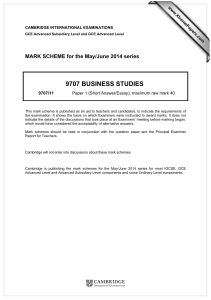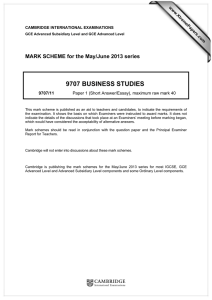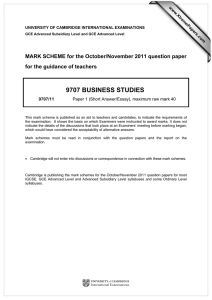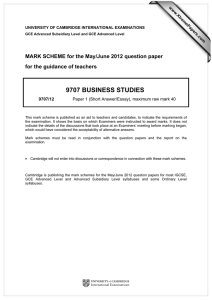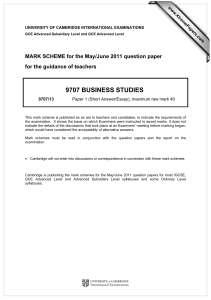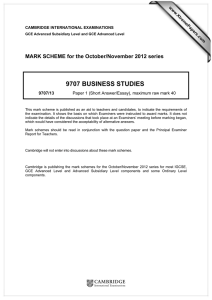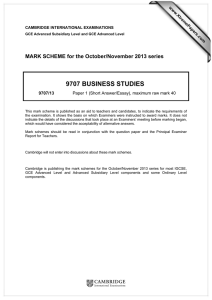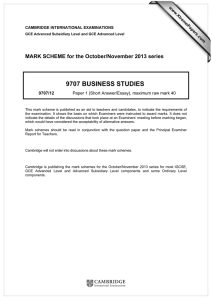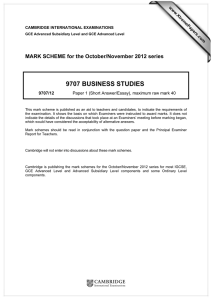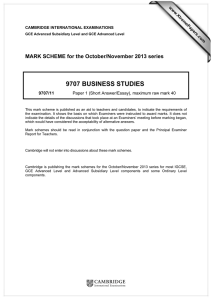9707 BUSINESS STUDIES MARK SCHEME for the October/November 2011 question paper
advertisement
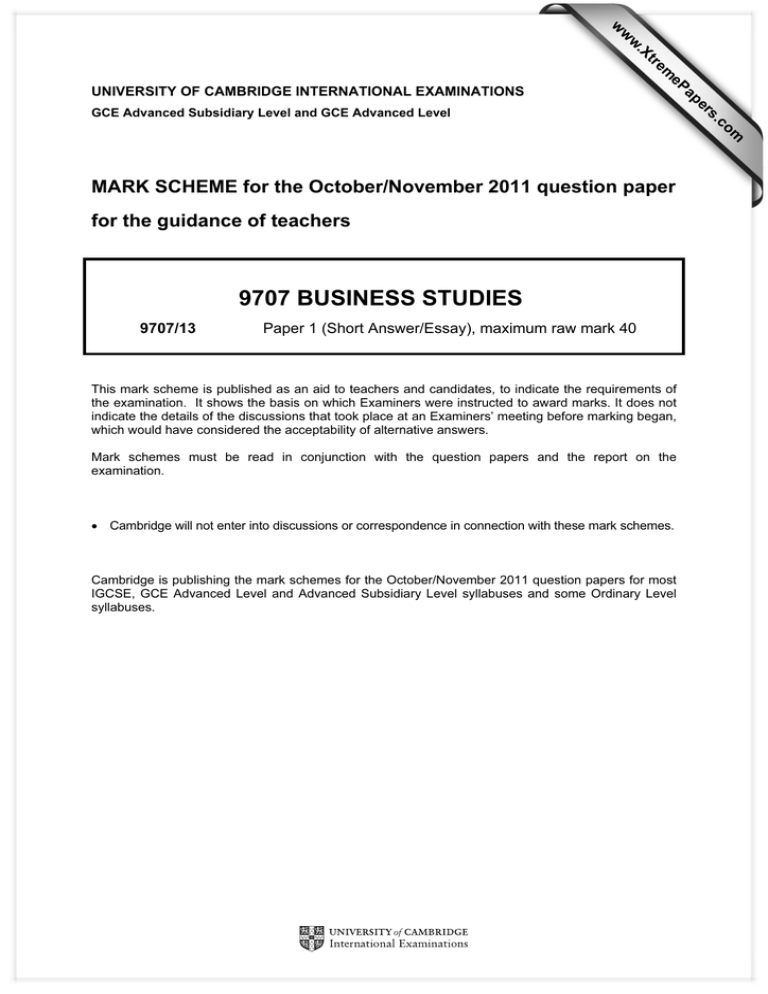
w w ap eP m e tr .X w UNIVERSITY OF CAMBRIDGE INTERNATIONAL EXAMINATIONS for the guidance of teachers 9707 BUSINESS STUDIES 9707/13 Paper 1 (Short Answer/Essay), maximum raw mark 40 This mark scheme is published as an aid to teachers and candidates, to indicate the requirements of the examination. It shows the basis on which Examiners were instructed to award marks. It does not indicate the details of the discussions that took place at an Examiners’ meeting before marking began, which would have considered the acceptability of alternative answers. Mark schemes must be read in conjunction with the question papers and the report on the examination. • Cambridge will not enter into discussions or correspondence in connection with these mark schemes. Cambridge is publishing the mark schemes for the October/November 2011 question papers for most IGCSE, GCE Advanced Level and Advanced Subsidiary Level syllabuses and some Ordinary Level syllabuses. om .c MARK SCHEME for the October/November 2011 question paper s er GCE Advanced Subsidiary Level and GCE Advanced Level Page 2 Mark Scheme: Teachers’ version GCE AS/A LEVEL – October/November 2011 Syllabus 9707 Paper 13 This mark scheme includes a summary of appropriate content for answering each question. It should be emphasised, however, that this material is for illustrative purposes and is not intended to provide a definitive guide to acceptable answers. It is quite possible that among the scripts there will be some candidate answers that are not covered directly by the content of this mark scheme. In such cases, professional judgement should be exercised in assessing the merits of the answer. Examples of possible answers may also be included in this mark scheme. Again, it should be emphasised that this is for illustrative purposes and the examples chosen represent only some of the many possible responses that would merit reward. Section A 1 (a) A partnership is two or more people forming an unincorporated business with unlimited liability status – normally with the objective of making a profit. There is joint responsibility for running the business and for sharing the profits/losses. A partnership may be regulated by a partnership agreement. A definition that indicates partial understanding. A definition that indicates full understanding. [1] [2] (b) Advantages could include: • possibly greater input of financial investment • more skills and expertise available and more opportunity for specialisation • partners can share decision-making, give moral and practical support to each other • share the risks • possibly easier to raise external funds • generally share the workload. Partial explanation of ONE advantage. Full explanation of ONE advantage or partial explanation of TWO. Full explanation of TWO advantages. 2 [1] [2] [3] (a) Internal sources of finance include: • retained profits • sale of assets • working capital (current assets minus current liabilities) • owners’ (shareholders’) own funds • bank loans. ONE accurate internal source of business funding stated. TWO accurate internal sources of business funding stated. © University of Cambridge International Examinations 2011 [1] [2] Page 3 Mark Scheme: Teachers’ version GCE AS/A LEVEL – October/November 2011 Syllabus 9707 Paper 13 (b) Acceptable sources will include: • long-term/medium-term loans • leasing • mortgage • issuing shares • venture capital • debentures • selling fixed assets. Partial explanation of ONE source. Full explanation of ONE source or partial explanation of TWO sources. Full explanation of TWO sources. 3 [1] [2] [3] An important part of the marketing of products or services is differentiation – the attempt to create a significant perception of difference between a product/service of one business and that of its competitors. This is just as true for tertiary sector services as it is for manufactured products. Services from banks, financial service companies and retailers are branded and differentiated through distinctive offerings (e.g. superb customer service standards) – a feature or benefit that separates or differentiates a service from its competitors. Service differentiation can: • give high levels of market recognition • secure larger market share • produce higher profits • create more of a monopoly position • ring-fence particular services. Accurate explanation of product/service differentiation. [1] Clear explanation of product/service differentiation, with some reference to why businesses seek to differentiate. [2–3] A developed explanation of why businesses seek to differentiate. [4] As above, with explicit reference to the tertiary sector. [5] 4 (a) Induction training is a programme to: • assist newly-appointed employees to settle in and feel comfortable in a new organisation/job • receive information about the organisation/job, personnel policies, culture, regulations, systems, structures etc. Definition indicates partial understanding. Definition indicates full understanding. © University of Cambridge International Examinations 2011 [1] [2] Page 4 Mark Scheme: Teachers’ version GCE AS/A LEVEL – October/November 2011 Syllabus 9707 Paper 13 (b) Purpose of staff training is to secure the required skills and competencies for employees, and so: • increase performance • achieve objectives • increase quality of provision, profitability • create a more versatile work-force • help introduce more technology • assist in the management of change • improve job satisfaction, motivation • reduce accidents • comply with externally-imposed regulations • improve employee chances of promotion • improve the image of the business etc. An investment of resources that smaller businesses may not be able to afford and one that successful larger businesses regard as an important investment. Limited understanding of staff training. Some explanation of reason(s) for staff training. Full explanation of reason(s) for staff training. [1] [2] [3] Section B 5 (a) Technology has: • given power to customers, who can choose when and how they want marketing messages (or if they want them at all) • given a vast array of new media options to marketing professionals • increased the reach and targeting power of marketing – Internet, ipods, blogging, mobile technology • changed how brands are built and managed – brand loyalties once assumed to be givens challenged with consumer access to competitive information through new technology channels • measurement of marketing impact can now be more readily quantified • marketing landscape more complex, requiring more flexible and innovative marketing activities and responses. Candidates will probably not focus so much on these fundamental principles as explain the impact of the Internet and mobile technology on marketing activities (web-marketing/online marketing, e-marketing), giving examples of Internet marketing such as direct sales to customers, targeted Internet marketing campaigns, showing design features of products and services as customers research products at their own convenience. Reference might be made to the opportunity to reach a wide audience for a small fraction of a traditional advertising budget and to measure at a click the impact of different messages – social media in general, e.g. Facebook and Twitter. Analysis of how technology has influenced marketing activities. Good explanation of how technology has influenced marketing activities. Limited explanation of how technology has influenced marketing activities. Some very limited reference to technology. © University of Cambridge International Examinations 2011 [7–8] [5–6] [3–4] [1–2] Page 5 Mark Scheme: Teachers’ version GCE AS/A LEVEL – October/November 2011 Syllabus 9707 Paper 13 (b) The benefits could include: • improvements in quality of design and manufacture • more standardised product quality, less room for human error • improved productivity, allowing for 24/7 production – no need for rest days or holidays • lower average costs (extra fixed cost more than compensated by reduction in operating costs) • speedier development of new cars • quicker process of product design and development – animation and virtual reality can conserve resources (time, materials, energy) • lead to more customer choice, more flexible manufacturing, less lead time, less waste, higher finished quality. The drawbacks might be: • higher fixed costs • the high initial cost of installing and updating the new technology – major capital investment required • retraining costs as equipment is constantly updated to ensure that new technology is used effectively • demotivation as automation can lead to skilled workers being reduced to machinery operators, leading to reduced levels of worker motivation • loss of jobs and the need to reorganise the work-place and the working environment. Evaluative comment on the benefits and drawbacks of using new technology in context (e.g. on balance is it good or bad?). [11–12] Analysis of benefits and drawbacks of using new technology in context. [8–10] Describes some benefits and/or drawbacks of new technology in context. [3–7] Limited discussion of new technology. [1–2] 6 Answers might initially define stakeholders and then identify different ones in this business context – company closure: • Employee – job losses, possibility of getting new jobs, depends on local and national economic situation, probably low skill base, impact on personal family situation. • Customers – loss of traditional store, reduced choice (though may already have switched shopping loyalties thus causing the closure). • Shareholders – if a plc, share price probably hit the floor, giving significant losses. • Local community – job losses have a multiplier effect leading to local economic depression, impact of large empty shops in shopping areas. • Suppliers – possible short-term losses, in search of new buyers. • Competitors – opportunity to move into the gap created by the closure etc. Impact depends on the severity of the economic situation and some stakeholders damaged more than others. Evaluative comment on the impact of this closure on specific stakeholders (possible comment on the relative damage done, worst/least affected). [17–20] Analysis of the impact of this closure on specific stakeholders. [14–16] Good understanding of the impact on specific stakeholders. [11–13] Some understanding of the impact on specific stakeholders. [5–10] Limited comments on stakeholders and/or retail stores. [1–4] © University of Cambridge International Examinations 2011 Page 6 7 Mark Scheme: Teachers’ version GCE AS/A LEVEL – October/November 2011 Syllabus 9707 Paper 13 (a) Answers may initially describe McGregor’s classification of theory X and Y as perhaps a stark choice in making assumptions about those who a leader intends to lead and manage. (Theory X: employees don’t like working, do as little as they can, need to be told what to do, only interested in money, must be closely watched. Theory Y: employees enjoy their work, will work hard to gain rewards, will work unsupervised, are motivated by things other than money.) The classification identifies different assumptions that leaders may make in respect of employee attitudes to work. It suggests that as a result of these different assumptions, leaders may respond differently to the leadership role or may recognise that different responses are legitimate and appropriate. It informs leaders that there is not a one-track approach to leadership and management. It reminds leaders that leadership and management are complex activities and the issues raised in theory X and Y provide direction and understanding for thoughtful leaders. Analysis of theory X and theory Y with comment on usefulness. Good explanation of theory X and theory Y (usefulness perhaps implicit). Limited explanation of theory X and theory Y. Little understanding of theory X and theory Y. [7–8] [5–6] [3–4] [1–2] (b) Initially perhaps a description of autocratic and laissez-faire leadership style options. Strong candidates (as in part (a)) may well recognise that any particular leadership style chosen and its appropriateness depend on factors such as: • the business context – production/manufacturing culture, service business, public sector business, small/large business • the expectations, experience and aspirations of employees • the objectives and culture of particular businesses • the skills, competencies, and predilections of leaders themselves. Autocratic style may be appropriate for crisis or emergency situations where explicit orders are required and expected (military, rescue services, public order). Laissez-faire style may be more appropriate for a group of professional workers such as architects where creativity and innovation are expected and encouraged. Some evaluative comment on identified factors that leaders may take into account when choosing one or both of the two leadership styles. [11–12] Analysis of factor(s) that leaders may take into account when choosing one or both of the two leadership styles. [8–10] Some descriptive identification of factor(s) that leaders might take into account when choosing one or both of the two leadership styles. [3–7] Some limited comment on one or both of the two leadership styles. [1–2] © University of Cambridge International Examinations 2011
